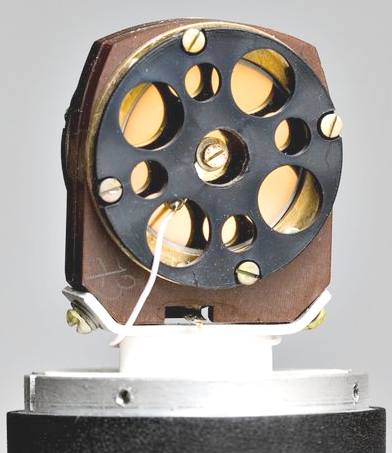|
MICROPHONES
|
||||||||||
|
HOME | BIOLOGY | FILMS | GEOGRAPHY | HISTORY | INDEX | MUSIC | SOLAR BOATS | SPORT | SPONSORS |
||||||||||
|
A microphone, sometimes referred to as a mike or mic (pronounced "mike"), is an acoustic to electric transducer that converts sound into an electrical signal. Microphones are used in many applications such as telephones, tape recorders, hearing aids, motion picture production, live and recorded audio engineering, in radio and television broadcasting and in computers for recording voice, VoIP and numerous other computer applications.
An Oktava condenser microphone
Invention
The word "microphone" (Greek mikros "small" and phone "sound") originally referred to a mechanical hearing aid for small sounds.[1]
The invention of a practical microphone was crucial to the early development of the telephone system. Emile Berliner invented the first microphone on March 4, 1877, but the first useful microphone was invented by Alexander Graham Bell. Many early developments in microphone design took place in Bell Laboratories. Principle of operation
All microphones capture sound waves with a thin, flexible diaphragm (or ribbon in the case of ribbon microphones). The vibrations of this element are then converted by various methods into an electrical signal that is an analog of the original sound. Most microphones in use today use electromagnetic generation (dynamic microphones), capacitance change (condenser microphones) or piezoelectric generation to produce the signal from mechanical vibration.
Microphone varietiesCapacitor or condenser microphones
In a capacitor microphone, also known as a condenser microphone, the diaphragm acts as one plate of a capacitor, and the vibrations produce changes in the distance between the plates. Since the plates are biased with a fixed charge (Q), the voltage maintained across the capacitor plates changes with the vibrations in the air, according to the capacitance equation:
where Q = charge in coulombs, C = capacitance in farads and V = potential difference in volts. The capacitance of the plates is inversely proportional to the distance between them for a parallel-plate capacitor.:
Capacitor microphones can be expensive and require a power supply, commonly provided from mic inputs as phantom power, but give a high-quality sound signal and are now the preferred choice in laboratory and studio recording applications.
Electret capacitor microphones
An electret microphone is a relatively new type of condenser microphone invented at Bell laboratories in 1962 by Gerhard Sessler and Jim West [2], and often simply called an electret microphone. An electret is a dielectric material that has been permanently electrically charged or polarised. The name comes from electrostatic and magnet; a static charge is embedded in an electret by alignment of the static charges in the material, much the way a magnet is made by aligning the magnetic domains in a piece of iron. They are used in many applications, from high-quality recording and lavalier use to built-in microphones in small sound recording devices and telephones. Though electret mikes were once considered low-cost and low quality, the best ones can now rival capacitor mikes in every respect (apart from low noise) and can even have the long-term stability and ultra-flat response needed for a measuring microphone. Unlike other condenser microphones, they require no polarising voltage, but normally contain an integrated preamplifier which does require power (often incorrectly called polarizing power or bias). This preamp is frequently phantom powered in sound reinforcement and studio applications. While few electret microphones rival the best DC-polarized units in terms of noise level, this is not due to any inherent limitation of the electret. Rather, mass production techniques needed to produce electrets cheaply don't lend themselves to the precision needed to produce the highest quality microphones. Dynamic microphones
In a dynamic microphone a small movable induction coil, positioned in the magnetic field of a permanent magnet, is attached to the diaphragm. When sound enters through the windscreen of the microphone, the sound wave vibrations move the diaphragm. When the diaphragm vibrates, the coil moves in the magnetic field, producing a varying current in the coil through electromagnetic induction. The principle is exactly the same as in a loudspeaker, only reversed. Dynamic microphones are robust, relatively inexpensive, and resistant to moisture, and for this reason they are widely used on-stage by singers. They tend to have a poor low-frequency response, which is advantageous for reducing handling noise as a vocal mic, but tends to exclude them from other uses.
Ribbon microphones
In ribbon microphones a thin, usually corrugated metal ribbon is suspended in a magnetic field. The ribbon is electrically connected to the microphone's output, and its vibration within the magnetic field generates the electrical signal. Basic ribbon microphones detect sound in a bidirectional (also called figure-eight) pattern because the ribbon, which is open to sound both front and back, responds to the pressure gradient rather than the sound pressure. Though the symmetrical front and rear pickup can be a nuisance in normal stereo recording, the high side rejection can be used to advantage by positioning a ribbon mic horizontally, for example above cymbals, so that the rear lobe picks up only sound from the ceiling. Other directional patterns are produced by enclosing one side of the ribbon in an acoustic trap or baffle, allowing sound to reach only one side. Ribbon mics give very high quality sound reproduction, and were once valued for this reason, but a good low-frequency response can be obtained only if the ribbon is suspended very loosely, and this makes them fragile. Protective wind screens can reduce the danger of damaging the ribbon, but will somewhat reduce the bass response at large miking distances.
Ribbon microphones don't require phantom power; in fact, this voltage can damage these microphones.
Inside the Oktava 319 condenser microphone
Carbon microphones
A carbon microphone, formerly used in telephone handsets, is a capsule containing carbon granules pressed between two metal plates. A voltage is applied across the metal plates, causing a small current to flow through the carbon. One of the plates, the diaphragm, vibrates in sympathy with incident sound waves, applying a varying pressure to the carbon. The changing pressure deforms the granules, causing the contact area between each pair of adjacent granules to change, and this causes the electrical resistance of the mass of granules to change. The changes in resistance cause a corresponding change in the voltage across the two plates, and hence in the current flowing through the microphone, producing the electrical signal. Carbon microphones were once commonly used in telephones; they have extremely low-quality sound reproduction and a very limited frequency response range, but are very robust devices. Unlike other microphone types, the carbon microphone can also be used as a type of amplifier, using a small amount of sound energy to produce a larger amount of electrical energy. Carbon microphones found use as early telephone repeaters, making long distance phone calls possible in the era before vacuum tubes. These repeaters worked by mechanically coupling a magnetic telephone receiver to a carbon microphone: the faint signal from the receiver was transferred to the microphone, with a resulting stronger electrical signal to send down the line. Piezo microphones
A piezo (pronounced "pee-ay-zo" or "pie-ee-zo") microphone uses the phenomenon of piezoelectricity—the ability of some materials to produce a voltage when subjected to pressure—to convert vibrations into an electrical signal. Piezo transducers are often used as contact microphones to amplify acoustic instruments for live performance, or to record sounds in unusual environments (underwater, for instance).
An example of this is Rochelle salt (potassium sodium tartrate), which is a piezoelectric crystal that works as a transducer both ways; it is also commonly used as a slimline loudspeaker component.
Laser microphones
A laser microphone is an exotic application of laser technology. It consists of a laser beam that must be reflected off a glass window or another rigid surface that vibrates in sympathy with nearby sounds. This device essentially turns any vibrating surface near the source of sound into a microphone. It does this by measuring the distance between itself and the surface extremely accurately; the tiny fluctuations in this distance become the electrical signal of the sounds picked up. Laser microphones are new, very rare and expensive, and are most commonly portrayed in the movies as spying devices.
Speakers as microphones
A loudspeaker is the exact opposite of a microphone, since it's a transducer that turns an electrical signal into sound waves. However, because a conventional speaker is constructed much like a dynamic microphone (with a diaphragm, coil and magnet), speakers can actually work "in reverse" as microphones. The result, though, is a microphone with poor quality, limited frequency response (particularly at the high end), and poor sensitivity.
In practical use, speakers are sometimes used as microphones in such applications as intercoms or walkie-talkies, where high quality and sensitivity are not needed. However, there is at least one other novel application of this principle; using a medium-size woofer placed closely in front of a "kick" (bass drum) in a drum set to act as a microphone. This has been commercialized with the Yamaha "Subkick".[3]
Other microphone types
A pressure gradient microphone is a microphone in which both sides of the diaphragm are exposed to the incident sound and the microphone is therefore responsive to the pressure differential (gradient) between the two sides of the membrane. Sound incident parallel to the plane of the diaphragm produces no pressure differential, giving pressure-gradient microphones their characteristic figure-eight directional patterns. They are also called "velocity microphones", since the output voltage is proportional to the air particle velocity.
A lavalier microphone is made for hands-free operation. These small microphones are worn on the body and held in place either with a lanyard worn around the neck or a clip fastened to clothing. The cord may be hidden by clothes and either run to an RF transmitter in a pocket or clipped to a belt (for mobile use), or run directly to the mixer (for stationary applications).
A wireless microphone is one which does not use a cable. It usually transmits its signal using a small FM radio transmitter to a nearby receiver connected to the sound system, but it can also use infrared light if the transmitter and receiver are within sight of each other.
A contact microphone is designed to pick up vibrations directly from a solid surface or object, as opposed to sound vibrations carried through air. One use for this is to detect sounds of a very low level, such as those from small objects or insects. The microphone commonly consists of a magnetic (moving coil) transducer, contact plate and contact pin. The contact plate is placed against the object from which vibrations are to be picked up; the contact pin transfers these vibrations to the coil of the transducer. Contact microphones have been used to pick up the sound of a snail's heartbeat and the footsteps of ants. A portable version of this microphone has recently been developed.
A throat microphone is a variant of the contact microphone, used to pick up speech directly from the throat, around which it is strapped. This allows the device to be used in areas with ambient sounds that would otherwise make the speaker inaudible.
A parabolic microphone uses a parabolic reflector to collect and focus sound waves onto a microphone receiver, in much the same way that a parabolic antenna (e.g. satellite dish) does with radio waves. Typical uses of this microphone, which has unusually focused front sensitivity and can pick up sounds from many meters away, include nature recording, outdoor sporting events, eavesdropping, law enforcement, and even espionage. Parabolic microphones are not typically used for standard recording applications, because they tend to have poor low-frequency response as a side effect of their design.
Connectivity
Connectors
The most common connectors used by microphones are:
Some microphones use other connectors, such as TRS, 5-pin XLR, or stereo mini phone plug on some stereo microphones. Some lavaliers have a proprietary connector to connect them to their transmitter. Since 2005, professional-quality microphones with USB connections have begun to appear, designed for direct recording into computer-based software studios.
Impedance matching
Microphones have an electrical characteristic called impedance, measured in ohms (Ω) that depends on the design. Low impedance is considered under 600 Ω. Medium impedance is considered between 600 Ω and 10 kΩ. High impedance is above 10 kΩ. Most professional microphones are low impedance, about 200 Ω. Less expensive models have an impedance of at least 600 Ω. Low-impedance microphones are preferred over high impedance on long-run cables for two reasons: one is that using a high-impedance mike with a long cable is likely to result in loss of high frequency signal; the other is that long high-impedance cables tend to pick up more hum (and possibly radio-frequency interference (RFI) as well).
To get the best sound, the impedances of the microphone and the equipment to which it is connected must match. There are transformers (called matching transformers) that adapt impedances, such as DI units. In general, any XLR microphone can be connected to any mixer with XLR inputs, and any plug microphone can be connected to any jack plug that is marked as a microphone input, but it can't be connected to a line input.
Directionality
A microphone's directionality or polar pattern indicates how sensitive it is to sounds arriving at different angles about its central axis. The polar pattern represents the locus of points that produce the same signal level output in the microphone if a given sound pressure level is generated from that point.
An omnidirectional microphone's response is generally considered to be a perfect sphere in three dimensions. In the real world, this is not the case. As with directional microphones, the polar pattern for an "omnidirectional" microphone is a function of frequency. The body of the microphone is not infinitely small and, as a consequence, it tends to get in its own way with respect to sounds arriving from the rear, causing a slight flattening of the polar response. This flattening increases as the diameter of the microphone (assuming it's cylindrical) reaches the wavelength of the frequency in question. Therefore, the smallest diameter microphone will give the best omnidirectional characteristics at high frequencies. The wavelength of sound at 10 kHz is about an inch (2.5 cm) so the smallest measuring microphones are often 1/4" (6 mm) in diameter, which practically eliminates directionality even up to the highest frequencies. Omnidirectional microphones, unlike cardioids, do not employ resonant cavities as delays, and so can be considered the "purest" mikes in terms of low coloration; they add very little to the original sound. Being pressure-sensitive they can also have a very flat low-frequency response down to 20 Hz or below. Pressure-sensitive mikes also respond much less to wind noise than directional (velocity sensitive) mikes.
A unidirectional microphone is sensitive to sounds from only one direction. The diagram above illustrates a number of these patterns, with the microphone capsule being represented as a red dot. The top of the diagram is the front of the mic. The sound intensity for a particular frequency is plotted for angles radially from 0 to 360°. (Professional diagrams show these scales and include multiple plots at different frequencies. These diagrams just provide an overview of the typical shapes and their names.)
The most common unidirectional mike is a cardioid microphone, so named because the sensitivity pattern is heart-shaped. A hyper-cardioid is similar but with a tighter area of front sensitivity and a tiny lobe of rear sensitivity. These two patterns are commonly used as vocal or speech mikes, since they are good at rejecting sounds from other directions. Because they employ internal cavities to provide front-back delay, directional mikes tend to have more coloration than omnis, and they also suffer from low-frequency roll-off. These problems are overcome to a large extent by careful design, but only the best cardioids can begin to approach the performance of a tiny low-cost omni in terms of absolute accuracy. This is not always recognised, but is the price paid for directionality, often needed to exclude ambient reverberation wherever very close placement is impossible.
Figure 8 or bi-directional mikes receive sound from both the front and back of the element. Most ribbon microphones are of this pattern.
Shotgun microphones are the most highly directional. They have small lobes of sensitivity to the left, right, and rear but are significantly more sensitive to the front. This results from placing the element inside a tube with slots cut along the side; wave-cancellation eliminates most of the off-axis noise. Shotgun microphones are commonly used on TV and film sets, and for location recording of wildlife.
An omnidirectional microphone is a pressure transducer; the output voltage is proportional to the air pressure at a given time.
On the other hand, a figure-8 pattern is a pressure gradient transducer; the output voltage is proportional to the difference in pressure on the front and on the back side. A sound wave arriving from the back will lead to a signal with a polarity opposite to that of an identical sound wave from the front. Moreover, shorter wavelengths (higher frequencies) are picked up more effectively than lower frequencies.
A cardioid microphone is effectively a superposition of an omnidirectional and a figure-8 microphone; for sound waves coming from the back, the negative signal from the figure-8 cancels the positive signal from the omnidirectional element, whereas for sound waves coming from the front, the two add to each other. A hypercardioid microphone is similar, but with a slightly larger figure-8 contribution.
Since directional microphones are (partially) pressure gradient transducers, their sensitivity is dependent on the distance to the sound source. This is known as the proximity effect, a bass boost at distances of a few centimeters. Measurements and specifications
Because of differences in their construction, microphones have their own characteristic responses to sound. This difference in response produces non-uniform phase and frequency responses. In addition, mics are not uniformly sensitive to sound pressure, and can accept differing levels without distorting. Although for scientific applications microphones with a more uniform response are desirable, this is often not the case for music recording, as the non-uniform response of a microphone can produce a desirable coloration of the sound. There is an international standard for microphone specifications (IEC 60268-4), but very few manufacturers adhere to it.
A frequency response diagram plots the microphone sensitivity in decibels over a range of frequencies (typically at least 0–20 kHz), generally for perfectly on-axis sound (sound arriving at 0° to the capsule). Frequency response may be less informatively stated textually like so: "20 Hz–20 kHz ±3 dB". This is interpreted as a (mostly) linear plot between the stated frequencies, with variations in amplitude of no more than 3 dB plus or minus. However, one cannot determine from this information how smooth the variations are, nor in what parts of the spectrum they occur. Note that commonly-made statements such as "20 Hz–20 kHz" are meaningless without a decibel measure.
The self-noise or equivalent noise level is the sound level that creates the same output voltage as the inherent noise of the microphone. This represents the lowest point of the microphone's dynamic range, and is particularly important should you wish to record sounds that are quiet. The measure is often stated in dBA, which is the equivalent loudness of the noise on a decibel scale frequency-weighted for how the ear hears, for example: "15 dBA SPL" (SPL means sound pressure level relative to 20 micropascals). The lower the number the better. Some microphone manufacturers state the noise level using ITU-R 468 noise weighting, which more accurately represents the way we hear noise, but gives a figure some 11 to 14 dB higher. A quiet microphone will measure typically 20 dBA SPL or 32 dB SPL 468-weighted.
The maximum SPL (sound pressure level) the microphone can accept is measured for particular values of total harmonic distortion (THD), typically 1%. This is generally inaudible, so one can safely use the mic at this level without harming the recording. Example: "142 dB SPL peak (<1% THD)". The higher the value, the better.
The clipping level is perhaps a better indicator of maximum useable level as the 1% THD figure usually quoted under max SPL is really a very mild level of distortion, quite inaudible especially on brief high peaks. Harmonic distortion from microphones is usually of low-order (mostly third harmonic) type, and hence not very audible even at 3-5%. Clipping, on the other hand, usually caused by the diaphram reaching its absolute displacement limit (or by the preamplifier), will produce a very harsh sound on peaks, and should be avoided if at all possible. For some mikes the clipping level may be much higher than the max SPL.
The dynamic range of a mike is the difference in SPL between the noise floor and the maximum SPL. If stated on its own, for example "120 dB", it conveys significantly less information than having the self-noise and maximum SPL figures individually.
Sensitivity indicates how well the mike converts acoustic pressure to output voltage. A high sensitivity mike creates more voltage and so will need less amplification at the mixer or recording device. This is a practical concern but not directly an indication of the mike's quality, and in fact the term sensitivity is something of a misnomer, 'transduction gain' being perhaps more meaningful, (or just "output level") because true sensitivity will generally be set by the noise floor, and too much "sensitivity" in terms of output level will compromise the clipping level. There are two common measures. The (preferred) international standard is made in mV per pascal at 1 kHz. A higher value indicates greater sensitivity. The older American method is referred to a 1 V/Pa standard and measured in plain dB, resulting in a negative value. Again, a higher value indicates greater sensitivity, so −60 dB is more sensitive than −70 dB.
Measurement microphones
Some microphones are intended for use as standard measuring microphones for the testing of speakers and checking noise levels etc. These are calibrated transducers and will usually be supplied with a calibration certificate stating absolute sensitivity against frequency. Microphone calibration techniquesPistonphone apparatus
A pistonphone is an acoustical calibrator (sound source) using a closed coupler to generate a precise sound pressure for the calibration of instrumentation microphones. The principle relies on a piston mechanically driven to move at a specified rate on a fixed volume of air to which the microphone under test is exposed. The air is assumed to be compressed adiabatically and the SPL in the chamber can be calculated from PV = const. The Piston phone method only works at low frequencies but can be accurate and is related to an easily calculable sound pressure level. The standard test frequency is usually around 250 Hz.
Reciprocal method
This method relies on the reciprocity of one or more microphones in a group of 3 to be calibrated. It can still be used when only one of the microphones is reciprocal (exhibits equal response when used as a microphone or as a loudspeaker).
Microphone techniques
There exist a number of well-developed microphone techniques used for miking musical, film, or voice sources. Choice of technique depends on a number of factors, including:
Basic techniques
There are several classes of microphone placement for recording and amplification.
Stereo recording techniques
There are two essential components to placing objects (phantom sources) in the stereo sound-field between the loudspeakers. These are the level difference Δ L, the relative loudness, and the time-delay difference Δ t, the difference in arrival time. The "interaural" signals (binaural ILD and ITD) at the ears are not the stereo microphone signals which are coming from the loudspeakers, and are called "interchannel" signals (Δ L and Δ t). These signals are normally not mixed. Loudspeaker signals are different from the sound arriving at the ear. See the section "Binaural recording for earphones". Conventional stereo recording for loudspeakers
The following microphone techniques can be used to capture the live "soundstage":
Surround Microphone Techniques
Binaural recording for earphones
Binaural recording is a highly specific attempt to recreate the conditions of human hearing, reproducing the full three-dimensional sound-field with earphones. Most binaural recordings use model of a human head, with microphones placed where the ear canal could be. A sound source is then recorded with all of the stereo and spatial cues produced by the head and human pinnae with frequency dependent ILD (interaural level difference) and ITD (interaural time difference, max. (Δt) = 630 µs = 0.63 ms) ear signals. A binaural recording is usually only somewhat successful, in addition to being highly inconvenient. For one thing, it tends to work well only when played back directly into the ear canal, via headphones (no speakers), as other methods of playback add additional spatial cues. Furthermore, as all heads and pinnae are different, a recording from one "pair of ears" will not always sound correct to another person. Also, headphones have a frequency response that compensates for the fact that the reflections from the pinnae, head and shoulders strongly affect the frequency spectrum, with the assumption that a recording is taken with a flat frequency spectrum. Introducing the spectral distortion already in the binaural recording results in an unnatural frequency spectrum, even when played through headphones. Finally, as visual cues are generally much more powerful than auditory cues when determining the source of a sound, binaural recordings are not always convincing to listeners.
Microphone manufacturers
LINKS
ALEN ORGAN STUDIOS (LONDON) LTDExtensive range of pipe organs built by Allen. A wholly owned British company established in 1969 to handle the sales, service and hire of Allen Organs in the U.K., with, over 3500 instruments installed in churches, schools, crematoria, concert halls, and private homes. Trada
Business Campus, Stocking Lane, Hughenden Valley, High Wycombe,
BAGPIPES of CALEDONIABagpipe retailer in Leith, Scotland, whichbegan in1981 with the setting up of the "International Piper" magazine with the late Captain John A MacLellan, former director of the Army School of Bagpipe Music at Edinburgh Castle. Lorn House, Links Gardens Lane, Leith, Edinburgh EH6 7JQ +44 (0) 131 553 5503 +44 (0) 131 553 5550 enquiries@bagpipesofcaledonia.com
BARNES & MULLINS Suppliers of guitars, PA's, effects, saxes and more.
BONNERS BONNERS A range of musical instruments for sale at Bonners Music instrument shops in Brighton and Eastbourne.
BOOSEY & HAWKES Publishers, online catalogue of instruments, music books CD's.
BRITISH RESERVE MUSICAL INSTRUMENT INSURANCEInsurance from Cornhill for musical instruments. Allianz
Cornhill Musical Insurance is one of the UK's leading specialist musical
instrument insurers. Pioneered cover for the music industry over 40 years
ago, under the British Reserve Insurance Company and continue to offer
flexible cost effective policies. Tel: 0870 2400 303
BROADWOOD PIANOS LTDProbably the oldest prestige piano companies in the world. Holds the Royal Warrant as manufacturer of pianos to Queen Elizabeth II.
COPEMAN HART ORGANSOrgan builders with a base in Northamptonshire. Founded in 1960, Copeman Hart enjoy an international reputation for producing not only the most pipelike sounds but the most comfortable, authentic consoles. COPEMAN
HART & COMPANY LIMITED Finedon Road, IRTHLINGBOROUGH,
Northamptonshire, ENGLAND, NN9 5TZ
Courtney PianosOxford based specialists in restoration and retail of traditional pianos, particularly the better-known makes/models built between the 1890s and 1940s.
(7,246)Drums, Drum Sets, and Accessories (4,459)Live Performance Equipment and Accessories (3,360)Keyboards / MIDI and Accessories (2,133)Guitars, Amps and Accessories (1,787)
Digital
Village is one of the UK's most comprehensive studio equipment, pro-audio
and computer music website. Digital Village have dedicated teams of
experts that will help you choose the right equipment for all your music
technology needs. For telephone mail-order, expert advice, price-beating
enquiries and the best package deals on your studio equipment, please
contact your nearest DV branch. Whether you choose to purchase
on-line, in-store or via telephone mail-order, contact Digital Village –
a supplier of professional recording equipment for over 25 years.
DOLPHIN MUSIC Next day delivery on all orders.
EBAY.CO.UKeBay is the world's largest online marketplace with over 10 million items for sale and 42 million registered users, eBay is the place to find the things you want or sell the items you have. Simply follow the instructions to register.
FENDER (UK) Fender guitars and amplification UK dealers and prices.
GUITAR SUPERSTORE Great site for guitars and everything guitar related.
GUITARIST MAGAZINE Well known magazine for guitarists.
GUITAR SCALEGuitar lessons on DVD, CD and video helping guitarists improve including beginners, intermediates and advanced players. Based in Hampshire. Tel: 0800 781 0414.
HERTFORD
MUSIC
H.J. FLETCHER & NEWMAN LTDThis
piano parts company, with an online catalogue, has been supplying piano
tuners, manufacturers, technicians, schools, colleges and universities all
round the world for over 120 years.
HOBGOBLIN
MUSIC
iMUSIC
SHOP
INSTRUMENT
ZONE
INSURANCEWIDEProtect your musical instruments against theft, damage and accidental loss. Policies can also provide new for old cover, hiring of replacement equipment, personal accident protection and public liability cover.
JACQUES SAMUEL PIANOS LTDIn 1935 Jaques Samuel began what was to become London’s largest independent piano house. 142 Edgware Road, Marble Arch, London, W2 2DZ Tel: +44 (0)20 7723 8818 Fax: +44 (0)20 7224 8692
JEFFREY SHACKELLConcert piano technician also offering piano accessories, transportation and hire service.
JOHN and ARTHUR BEAREViolin dealers, makers, repairers and restorers based in London.
MACARI'S MUSICAL INSTRUMENTSAmusing online journey around this excellent London guitar shop.
MACHINE HEAD Stockists of extensive range of guitars, amps, and accessories.
MARSHALL AMPLIFICATIONThe world famous Marshall Amplification Plc began in 1962 in London England where Jim Marshall had a music shop and taught the drums. Denbigh Road, Bletchley, Milton Keynes, Buckinghamshire, MK1 1DQ+44 1908 375411 +44 1908 376118 spares: 01908 375411 sales@marshallamps.com support@marshallamps.com
MUSIC
CENTRAL UK
MUSIC
CORNER
MUSICAL INSTRUMENTS FOR SALEOnline advert site for musicians, instrument manufacturers and traders. Our categories cover all musical instruments and accessories
MUSICAL WAREHOUSENew & second-hand musical instruments, mail order music shop with a personal touch, advertise concerts, instruments & services FREE, concerts, repairers, teachers, GCSE Help Page, music links, joke page.
MUSICROOM.COMThis site has a fantastic selection of sheet music, books about music, tutor methods and music accessories - covering a wide variety of instruments and genres.
MUSIC
STREET
MUSICAL WAREHOUSE Australian musical instruments.
MUSICIANS SHOP Discounted instruments and accessories with online facility.
NUSYSTEMS is an on-line store and mail order company for all your computer music and pro audio requirements. NUSYSTEMS build their own brand of Digital Audio Workstations (DAW) and Notebooks specifically for music production and recording.
Omega Music (UK) Ltd. has nearly 20 years' experience of operating a successful mail-order business. Noted for our integrity, we are one of the most respected music businesses in the north of England. Our Education Department supplies instruments and accessories to thousands of schools, colleges and universities nationwide. Our long-established retail store is the natural centre for music-making in our area and has on display one of the largest selections of musical instruments and accessories in the region.
PERIOD PIANO COMPANYA leading maker, restorers and dealers of antique pianos: grand, square, upright and fortepianos, based in Kent.
PETER SMITH & SONS Guidance/ advice offered on new and second hand pianos.
PIEDOG.COMOffers 4,000 products online, at competitive prices, for musicians of all types.
PILGRIM HARPSHarps, harp music, clarsach, pedal harps and concert harps. Founded in 1980 by a group of craftsmen, all experienced in harp making. Workshops are a converted coach house beside a large Victorian family home set in the Surrey countryside. Tel.
01342 893242 Fax. 01342 892646
E-mail: info@pilgrimharps.co.uk
PLAY
RECORD PREMIER PERCUSSION Information on percussion products, Leicestershire.
ROGER MAYER - ANALOGUE GUITAR EFFECTSGuitar effects consoles, with fascinating history attached - Roger has worked with many of the true greats. ROGER
MAYER ELECTRONIC DESIGN ASSOCIATES
SAXOPHONES.CO.UK Sales and rentals of saxophones, flutes and clarinets.
SIGNET
MUSIC
SOUND TECHNOLOGY PLC Guitars, basses, sound software and more.
STATUS GRAPHITE Hand-crafted graphite basses and guitars.
STRINGS DIRECT Order strings online; accessories cables, useful tutorial.
THE CLASSICAL GUITATR CENTRESuppliers of classical guitars and associated recorded music.
THE CONTRABASS SHOPPE Dealers in orchestral stringed instruments.
THE ORGAN WORKSHOPManufacturers and suppliers of hardware and software for the church based in Cheshire.
THE
STRING ZONE
THE TOTNES SCHOOL of GUITAR MAKINGThree
times a year, the Totnes School of Guitarmaking runs a 12-week course for
up to seven people. Each of them has chosen what kind
of guitar they want to make, and leaves at the end with the finished
instrument.
Think Music is a comprehensive direct musical instruments and equipment retailer. We have over 3000 product lines for you to browse and buy.
UK Websites Directory A new directory site worth a look!
WELLS-KENNEDY PARTNERSHIP LTDOrgan builders and installers in Northern Ireland, started in the garage adjoining the home of Christopher Gordon-Wells in 1966 then expanded into an old schoolhouse at Stoneyford north-west of Lisburn. Present Gregg Street workshop, was purchased in 1971 and has been steadily adapted and adjoining properties acquired for larger voicing shop and pipe store. 83-87
Gregg Street, Lisburn, BT27 5AW, Northern Ireland
WORLD OF MUSICOnline store for PA, guitars, drums, pianos and more. World
of Music Limited, 20 Denmark Street, London WC1 WYVERN CLASSICAL ORGANS LTDBuilders of pipeless organs based in Surrey. Wyvern Organ Buiders Ltd, Chobham, Woking, Surrey, GU24 8AQ. U.K. Tel: 01276 856363 Fax: 01256 855241 email: sales@wyvernorgans.co.uk
GIBSONThe home of Gibson electric guitars today is "Gibson USA," built in 1974 in Nashville specifically for the production of Gibson's Les Paul guitars. If
you have a comment or question about anything related to Gibson Musical
Instruments send an email to service@gibson.com.
We'll do our best to respond within 24 hours. You can reach the GMI
Customer Support staff 24 hours a day by calling 1-800-4-GIBSON
(1-800-444-2766). Entertainment Relations, 3rd Floor, 29-35 Rathbone Street, London, England, W1T 1NJ Tel. (0) 207.470.7800 Fax. (0) 207.470.7870 Email: service@gibson.com.
HIGHLY STRUNG INTERNATIONAL LTDOnline suppliers of a variety of equipment for guitarists.
STEINWAY & SONSFor 150 years Steinway has been dedicated to the ideal of making the finest pianos in the world. Site includes dealer locator. 1
Steinway Place, Long Island City, NY 11105
YAMAHA EUROPE Product information from Yamaha's extensive portfolio.
On receipt of your donation we will email you to confirm the contact and other details your want posted. Thank you for your for caring, your help and support.
Accessories Amplifiers Banjos Cellos Clarinets & Oboes Cornets DJ Equipment Effects Flutes & Piccolos French Horns Harmonicas Headphones Karaoke Keyboards Links Mandolins Microphones Mixers PA public address equipment Pianos Recording Equipment Saxophones Sound Modules Trombones Trumpets Ukuleles Violins
WARNER MUSIC GROUP (AOL TIME WARNER)
Music companies looking for acts: please stay tuned and contact our A&R department or write to the address below, when you spot someone with potential.
A taste for adventure capitalists
Solar Cola - a healthier alternative
|
||||||||||
|
This
website
is Copyright © 1999 & 2006 NJK. The bird |
||||||||||
|
AUTOMOTIVE | BLUEBIRD | ELECTRIC CARS | ELECTRIC CYCLES | SOLAR CARS |






